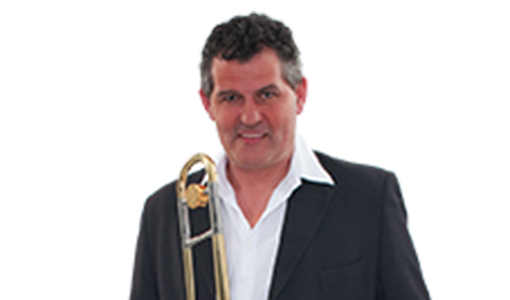Preparation for high-pitched trombone solos
In dem interaktiven Workshop geht es um die Beschreibung meiner eigenen Spielvorbereitung für hohe Posaunensolos. Diese individuelle Vorbereitung soll den Posaunisten Mut machen, ihre eigene persönliche Vorbereitung für ein Solo weiter zu entwickeln.
Die "Mutprobe" ersetzt natürlich auf keinen Fall das intensive Üben am Instrument, aber kann uns möglicherweise in Ausnahmesituationen Selbstvertrauen geben.
Playing under exceptional circumstances
Most musicians probably know the solo to "I’m Getting Sentimantal Over You". There are at least two reasons why you should never play it before your regular practice cycle: there are way too many sharps, and it goes all the way to the C2.
As you can hear, I took the liberty of extending the motif to the E2 for our warm-up. When I feel really daring, my readiness to take risks is close to 50%. Thinking too much about what can go wrong will cause you to be more tense, and if a note goes haywire...
The idea behind this test of courage is to lose your fear of something happening during a concert while you are only seconds away from playing a solo. Here are a few examples: it’s late, it’s too cold/too hot, not enough light, music rest in the wrong place, nothing to drink, no time to warm up, the monitors don’t work... in short: things that could happen anytime and often do.
The right embouchure for high-pitched trombone solos
The tone is carried by the air rather than the pressure applied to your lips with the mouthpiece. The only thing that changes while I play is my lip opening"”the mouthpiece’s pressure against my lips should be as light as possible. The correct contact feeling should give you the impression that your lips need to shape the opening through which the air escapes.
I use the F1 in the medium range as anchor. As I play higher notes, my lip opening gradually narrows (I think), while it gets wider for lower notes. Also, my lip opening for high notes tends to drop slightly towards the edge of the mouthpiece"”and to rise as I play lower notes.
This is a support mechanism for the muscles needed to hold the lip opening stable. When I play low notes, it creates the space I need to open my mouth a little wider, while for high notes, it becomes easier to narrow the lip opening.
Warming up for the solo
After the test of courage, I perform a series of exercises (in an almost random order) for warming up. All solo passages of the coming weeks definitely require regular and serious practice.
Seeing this workshop for some useful exercises.






